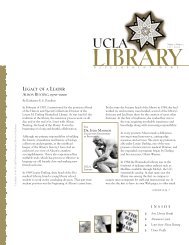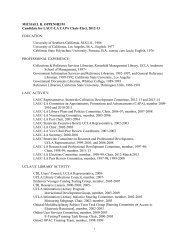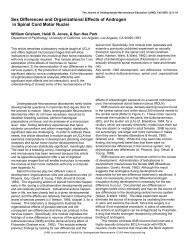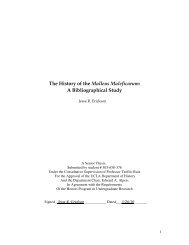Research Paper - UCLA Library
Research Paper - UCLA Library
Research Paper - UCLA Library
Create successful ePaper yourself
Turn your PDF publications into a flip-book with our unique Google optimized e-Paper software.
Gu 13<br />
political power as she approached death. Unfortunately, even the realm of glamorous portraiture<br />
was not safe from the fragmentation of monarchical authority. The marginalization of the aging<br />
monarch manifested itself in the rise in demand for the images of other admired court figures.<br />
Strong notes, “By 1600 the royal image was having to share the stage with that of other heroes,<br />
Essex, Cumberland, Nottingham and Mountjoy” (Strong, Gloriana 32). The old Elizabeth had<br />
major competition in the popularity contest of early modern politics and, without an heir, she<br />
was afraid of it. In August 1600, the Privy Council reacted to the popularity of engravings made<br />
of noblemen and called in all such objects of admiration; in this reactionary order to purge the<br />
market of non-royal images, “we are witnessing the breakdown of the cult of Elizabeth” (Strong,<br />
Gloriana 32).<br />
Elizabeth’s fear of being subjugated by the young noblemen of her court was a legitimate<br />
one. The Essex rebellion of February 1601 threatened the image of stability that she had worked<br />
so hard to maintain. Although the attempts of the second earl of Essex, Robert Devereux, to raise<br />
a revolt against the Queen ultimately failed, the event drew attention to Elizabeth’s carelessness.<br />
A king would not have allowed Devereux to overstep, but Elizabeth had allowed Essex to flatter<br />
her and play the part of the supplicating suitor. She had indulged her old favorite, tolerating his<br />
childish antics without curtailing the earl’s ambition; “the femininity which in many ways had<br />
served her so well, in this case had betrayed her” (Loades 100). Despite decades of propaganda,<br />
the cult of Elizabeth remained vulnerable and fragile, susceptible to physical and verbal attack.<br />
Aside from the political problems of Elizabeth’s final years, English society also<br />
“experienced a number of strains and dislocations between 1585 and 1603: demographic<br />
pressures, poverty, bad harvests, plague, the burdens of warfare, all of these contributed to the<br />
problems faced by government and the governed alike” (Sharpe 209). The final years of the











